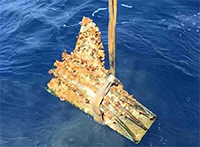|
Roman Naval Battering Rams Rise from the Seafloor
September 5, 2021
Archaeologists have found, at the bottom of the sea, battering rams used by the Romans against their ancient archenemy the Carthaginians. Ancient Rome and Ancient Carthage fought three wars known as the Punic Wars. Rome won all three, after the third administering the severe punishment of burning the city for two weeks, reducing it to ash. The First Punic War began in 264 B.C. and raged for 23 years. Roman forces won the fierce Battle of the Aegates on March 10, 241 B.C., and Carthage sued for peace. One of the ways that the Romans were so successful in that struggle was by equipping their warships with blade-tipped battering rams. Carthaginian warships featured such weapons as well, but Roman sailors proved more adept at bringing theirs to bear in a devastating way. Roman ships were lighter and more maneuverable and could thus inflict more damage on Carthaginian ships. The strategy was sometimes to ram an enemy ship on its side; other times, it was a head-on collision. No matter the method, Rome ultimately proved the master of this close-up conflict. Historians, estimate that Roman ships sank upwards of 50 Carthaginian ships in a single day, hastening the end of the war. A fisherman in 2010 discovered the first of what is now two dozen such battering rams. Investigations have taken place since then. Archaeologists at the Sicilian Marine Archaeology Unit have now found four more surviving Roman rams, on the seafloor off the coast of Sicily, where the battle took place centuries ago. Each bronze ram weighed 450 pounds and sported three blades on each side. Thrusting the ram against the hull of an enemy ship allowed the blades to ravage that ship's hull. |
|
Social Studies for Kids
copyright 2002–2024
David White





